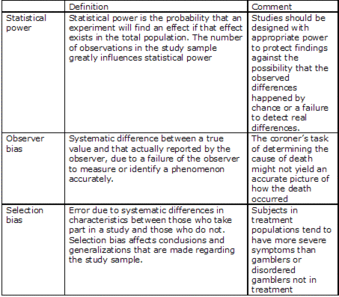On their own, suicide and pathological gambling wreak havoc and create turmoil: together their potential for devastation is certainly higher. Although many researchers have reported higher than expected suicide rates among pathological gamblers (see The WAGER: 1(12), 3(8), 3(48), 4(9), 4(28), 5(41), 7(35), 8(24), and 8(25)) and anecdotal evidence of a link is prolific, flaws in the scientific research have precluded definitive evidence that would allow us to draw confident conclusions about the presence or absence of a causal relationship between gambling and suicide within larger populations (National Research Council, 1999). Given the importance of this issue, this situation is very unfortunate. However, awareness of such flaws is the first step towards building a better evidence base. It is always important to read the methods, results, and conclusions of research studies with a healthy skepticism. In science, this healthy skepticism of study methodology acts as a catalyst for creating innovative ways to improve the design of research studies and provide stronger scientific evidence.
This issue of The WAGER, the first in a two part series, will discuss the methodological difficulties such as bias and statistical power in this area of study and the need to improve study methods. The second article in this series will address conceptual relationships (e.g., the correlation of suicide with other clinical issues such as depression) that complicate study methods even more.
To investigate the public health impact of gambling, the sample size for a research study needs to have an appropriate number of subjects for adequate statistical power. Failing to do so opens the possibility for type I and type II error (see Table 1).1 Like other important illnesses (e.g., schizophrenia), disordered gambling is a relatively low base rate disorder, and this makes it difficult for scientists to collect large community samples of people who have the disorder (Shaffer, Hall, & Vander Bilt, 1999). Scientists must design studies of gambling to compensate for this and protect their findings against power-related error.
Table 1. Definitions for Research and Statistical Terminology

Observer bias is another important methodological issue to consider. Some researchers have relied on coroners’ assessment of cause of death to illustrate a relationship between suicide and problem gambling. Coroner’s reports, however, could be biased. First, a definitive reason for death is impossible if there is no suicide note or any witnesses to the suicide. Second, coroners could be reluctant to record the cause of death as suicide for a number of reasons (e.g. prevent beneficiaries from collecting benefits from the deceased person’s life insurance, social stigma) leading to underreporting of gambling-related suicide (see The WAGER 5(41)). Third, pathological gambling has only recently been recognized as a potential cause of death, so many suicides attributed to other causes such as bankruptcy might be the result of pathological gambling.
Finally, selection bias can occur if the characteristics of the sample chosen for the study are systematically different from those of the population. Being a low base rate disorder, disordered gambling is particularly vulnerable to this possibility. For example, several recent studies of gambling and suicide (Kausch, 2003; Ledgerwood & Petry, 2004; Maccallum & Blaszczynski, 2003) are based on samples of patient populations receiving treatment for pathological gambling. Since subjects in treatment populations tend to have more severe problems than their counterparts in the community who do not seek treatment, estimates of suicides based on this population might not reflect the community at-large and might not be generalizable to disordered gamblers not in treatment.
Ultimately, however, researchers need to attend to this important issue with higher quality standards. Researchers should consider limitations of previous research, in terms of statistical power, observer bias, and selection bias, in order to improve scientific methods and provide stronger evidence in future studies. The next issue of the WAGER, the second part of this series, will discuss other factors that might account for the co-occurrence of suicide, suicidal ideation, and gambling.
What do you think? Comments on this article can be addressed to Allyson Peller.
Notes
1. Several factors, including the frequency of the condition being studied, the magnitude of the effect, the study design, and the sample size contribute to the power of the study.
References
Kausch, O. (2003). Suicide attempts among veterans seeking treatment for pathological gambling. Journal of Clinical Psychiatry, 64(9), 1031-1038.
Ledgerwood, D. M., & Petry, N. M. (2004). Gambling and suicidality in treatment-seeking pathological gamblers. Journal of Nervous and Mental Disorders, 192(10), 711-714.
Maccallum, F., & Blaszczynski, A. (2003). Pathological gambling and suicidality: an analysis of severity and lethality. Suicide and Life-Threatening Behavior, 33(1), 88-98.
National Research Council. (1999). Pathological Gambling: A Critical Review. Washington D.C.: National Academy Press.
Shaffer, H. J., Hall, M. N., & Vander Bilt, J. (1999). Estimating the prevalence of disordered gambling behavior in the United States and Canada: A research synthesis. American Journal of Public Health, 89(9), 1369-1376.




